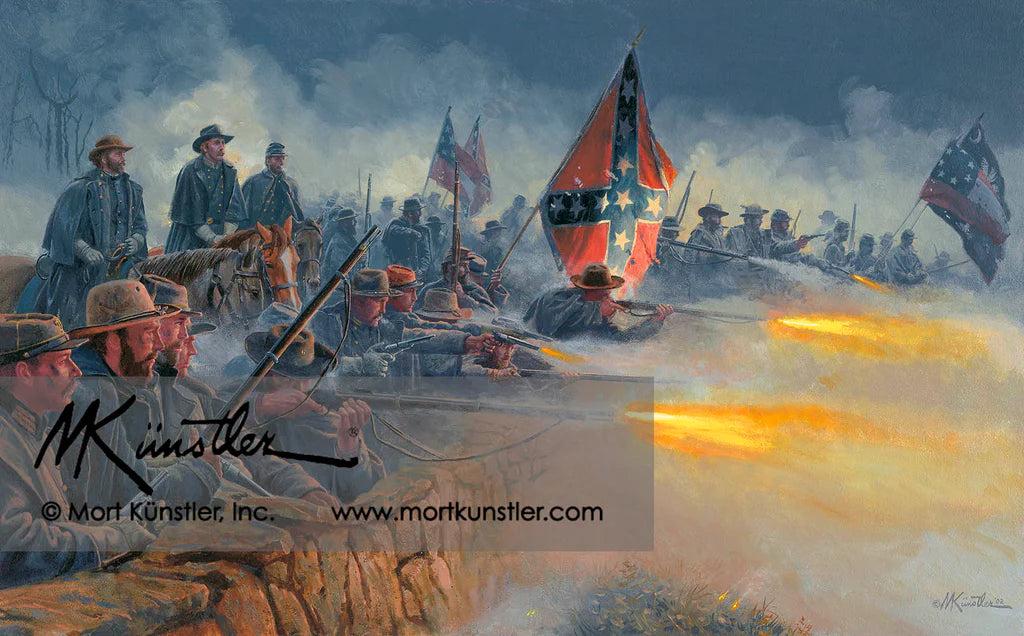Künstler
Valor in Gray
Valor in Gray
Couldn't load pickup availability
This is Mort Künstler limited edition print Valor in Gray - Kershaw's Bridge at Fredericksburg, December 13, 1862.
The Second in a Panoramic Set of Two Limited Edition Fine Art Prints
“Each print will stand on its own. Together the two prints will present a panoramic vista of the conflict at Marye’s Heights.” – Mort Künstler
Valor in Gray is a companion print to Courage in Blue - Chamberlain at Fredericksburg, December 13, 1862. Together, they portray the remarkable American heroism which became the lasting legacy of the Civil War.
Paper Prints
Reproduction technique: Fine offset lithography on neutral pH archival quality paper using the finest fade-resistant inks.
Each print is numbered and signed by the artist and accompanied by a Certificate of Authenticity.
Image Size: 14 3/4” x 23” • Overall Size: 20 1/4” x 28”
Signed & Numbered • Edition Size: 950
Signed Artist's Proof • Edition Size: 95
Giclée Canvas Prints
Reproduction technique: Giclées are printed with the finest archival pigmented inks on canvas.
Each print is numbered and signed by the artist and accompanied by a Certificate of Authenticity.
Size: 18” x 29”
Signed & Numbered • Edition Size: 100
Signed Artist's Proof • Edition Size: 10
Historical Information
They faced the most powerful army in America. Advancing in battle lines up the hill toward them was the mighty Army of the Potomac - more than 115,000 strong - composed of courageous, well-trained combat troops under the command of General Ambrose E. Burnside. For half a year, General Robert E. Lee’s Army of Northern Virginia had been persistently hammered by this great army, led by one Northern commander after another. Back in autumn at Antietam, the men in gray had escaped destruction by this same blue-uniformed host. Now they faced them again on the field of battle at Fredericksburg.
This time, however, they had a formidable advantage. They held an almost impregnable line of defense, which was anchored in a sunken road behind a stone wall on Marye’s Heights. The Northern troops advancing on them now in a mighty mass had to assault uphill over a long and open plain. Defending the Sunken Road were troops from Georgia, North Carolina, and Kershaw’s Brigade of South Carolinians, commanded by Brigadier General Joseph B. Kershaw. Descended from a prominent Southern family, Kershaw had been orphaned as a boy and had worked his way through life with remarkable success as a self-educated lawyer, a local militia officer, a Mexican War veteran, and a Confederate officer distinguished by a rapid rise in rank to brigadier general. Despite the numerical superiority of the men in blue at Fredericksburg, Kershaw held his brigade steady and poured forth a terrible fire from behind the stone wall.
Kershaw demonstrated “great coolness and skill,” observed a fellow officer, and helped transform the gigantic Federal assault into one of the North’s worst defeats. While Southern forces in the road and along the ridges behind it would lose a thousand men, the assaulting Northern forces would lose almost eight thousand. Finally, after making one courageous charge after another, the men in blue would give up. The Battle of Fredericksburg would be heralded as one of Robert E. Lee’s greatest victories - due in great measure to the valiant defense made by these sons of the South. It would long be celebrated in the Southern homeland as a triumph of valor in gray.
Mort Künstler's Comments
The more I study the American Civil War, the more I am impressed by the courage demonstrated by Americans on both sides. A classic example occurred at the Battle of Fredericksburg. Northern troops in the Army of the Potomac made repeated assaults over the wide-open killing fields below the Confederate line on Marye’s Heights. That’s what I tried to portray in Courage in Blue, which shows the 20th Maine charging up the hill in the thick of fighting - led by Lt. Col. Joshua Chamberlain. But what about the men on the other side? I kept thinking about them as I painted the 20th Maine. They faced a superior force composed of the finest army at the time – and they held their ground and drove back those grand legions in blue. This historical event is re-created in the Ron Maxwell motion picture Gods and Generals in a vivid, moving episode, and I am honored to be the official artist for Maxwell’s latest motion picture masterpiece.
I knew that I could not completely capture the dramatic display of American bravery at the Battle of Fredericksburg if I limited the scope of the painting to the Northern side of battle. At times, the opposing forces were no more than 25 yards apart. What absolute bravery was required for those men - Northerners and Southerners - to stand so close to each other and trade fire. How could an artist depict such an event on canvas? Then I thought to myself: Why not do two paintings? That would allow both images to be mounted side-by-side for a dramatic panoramic display worthy of the subject. Posted in the Sunken Road at Fredericksburg opposite the 20th Maine were the Southern soldiers of Brigadier General Joseph B. Kershaw’s brigade, which included troops from South Carolina, North Carolina and Georgia. Like the men of the 20th Maine, the soldiers of Kershaw’s Brigade were appropriate examples of American courage in the Civil War.
General Joseph B. Kershaw is seen in the painting, mounted on horseback, between two of his aides. He was a dignified lawyer with military experience in the Mexican War, and during the Civil War he was described as gallant and devout by his division commander. I deliberately show a good deal more gunfire in this painting than its Northern counterpart to demonstrate the overwhelming fire that the 20th Maine endured. I use the gun flashes to dramatically light the Confederate battle flag in the center of the painting. The first national flag, then still in use, can be seen in the background, as well as South Carolina’s Palmetto Flag.
The various interesting types of figures in the extreme left foreground and the ability to see down the Confederate line behind the stone wall to the right background gave me an opportunity to show all of the actions from loading to firing. I was also able to show that the two sides were so close to each other that the officers were firing with pistols. I think the panoramic concept works very well with both pictures, and together the images movingly express the extraordinary bravery that seemed to be evident on both sides during the war. And why not? They were all Americans.
Share


Continue Shopping
See more of the Breagans' collection of manufacturers from all around the world
Subscribe to our emails
Subscribe to our mailing list for insider news, product launches, and more.

